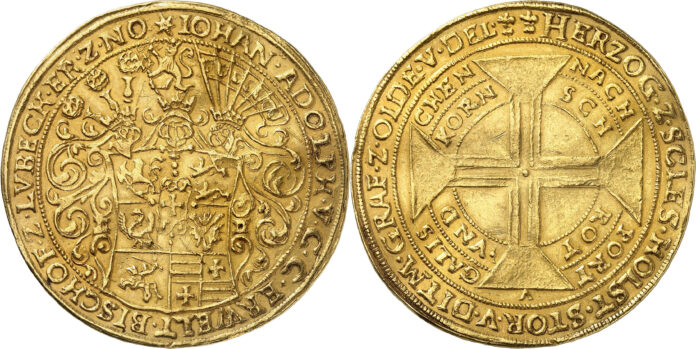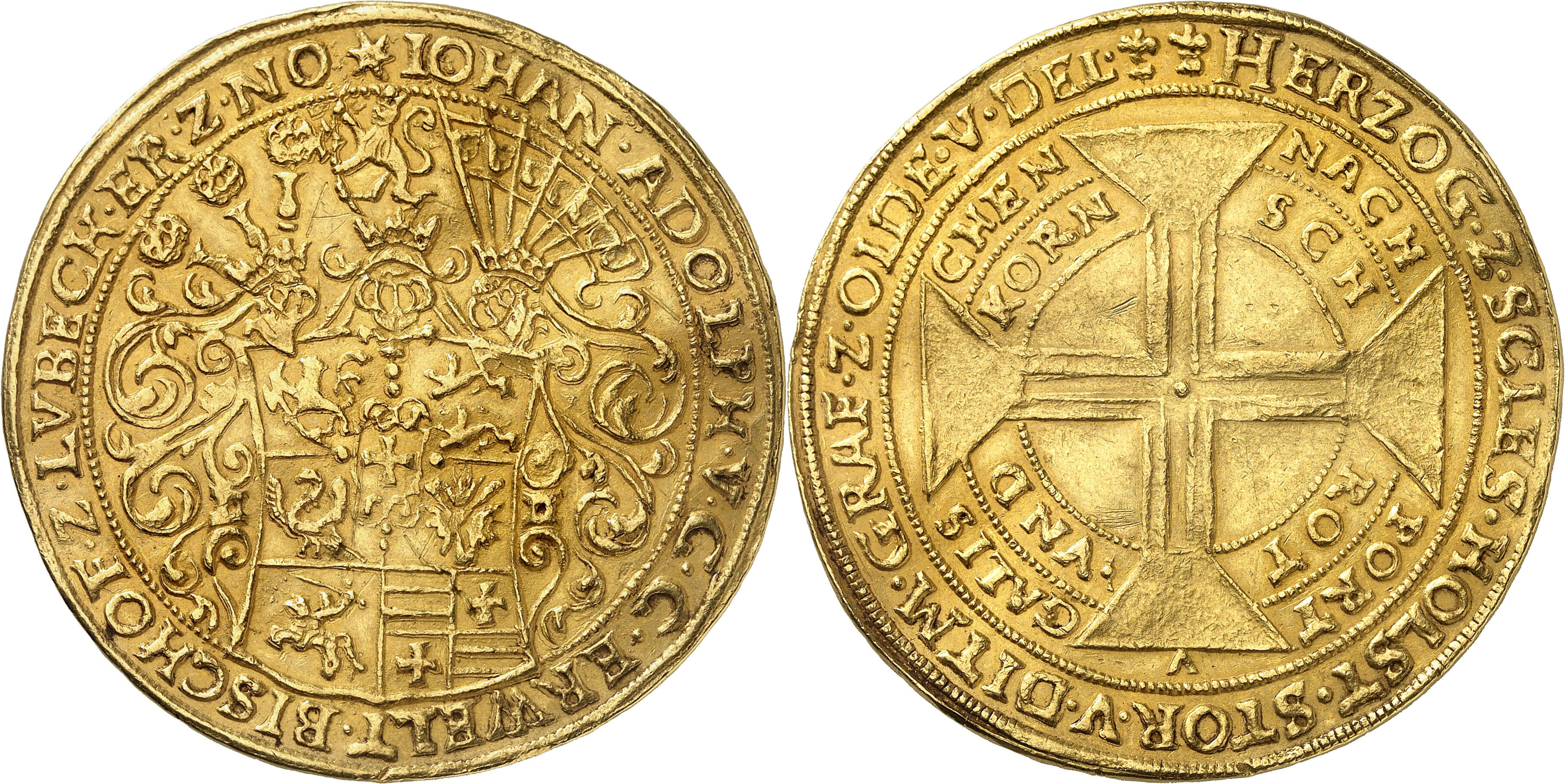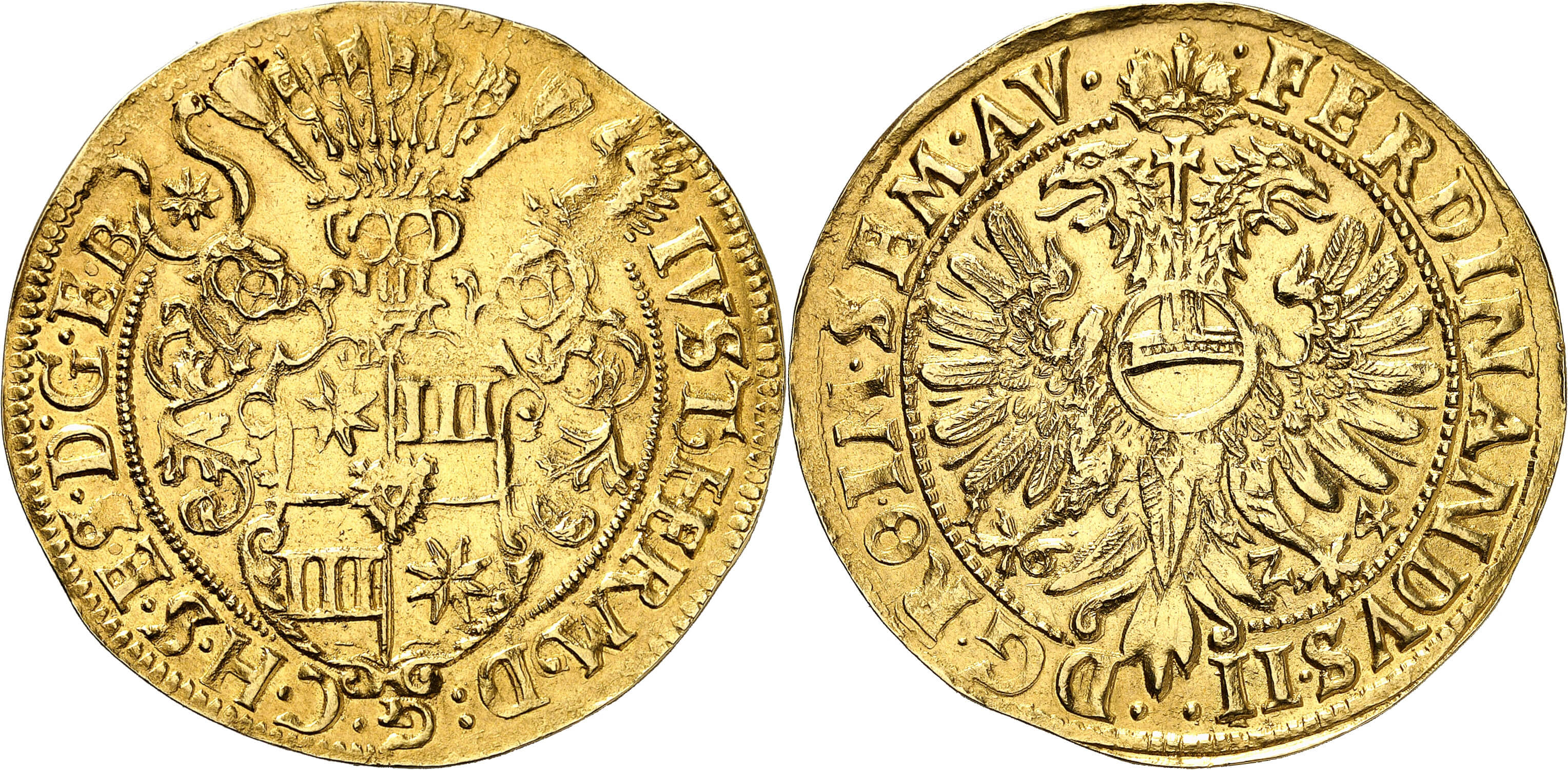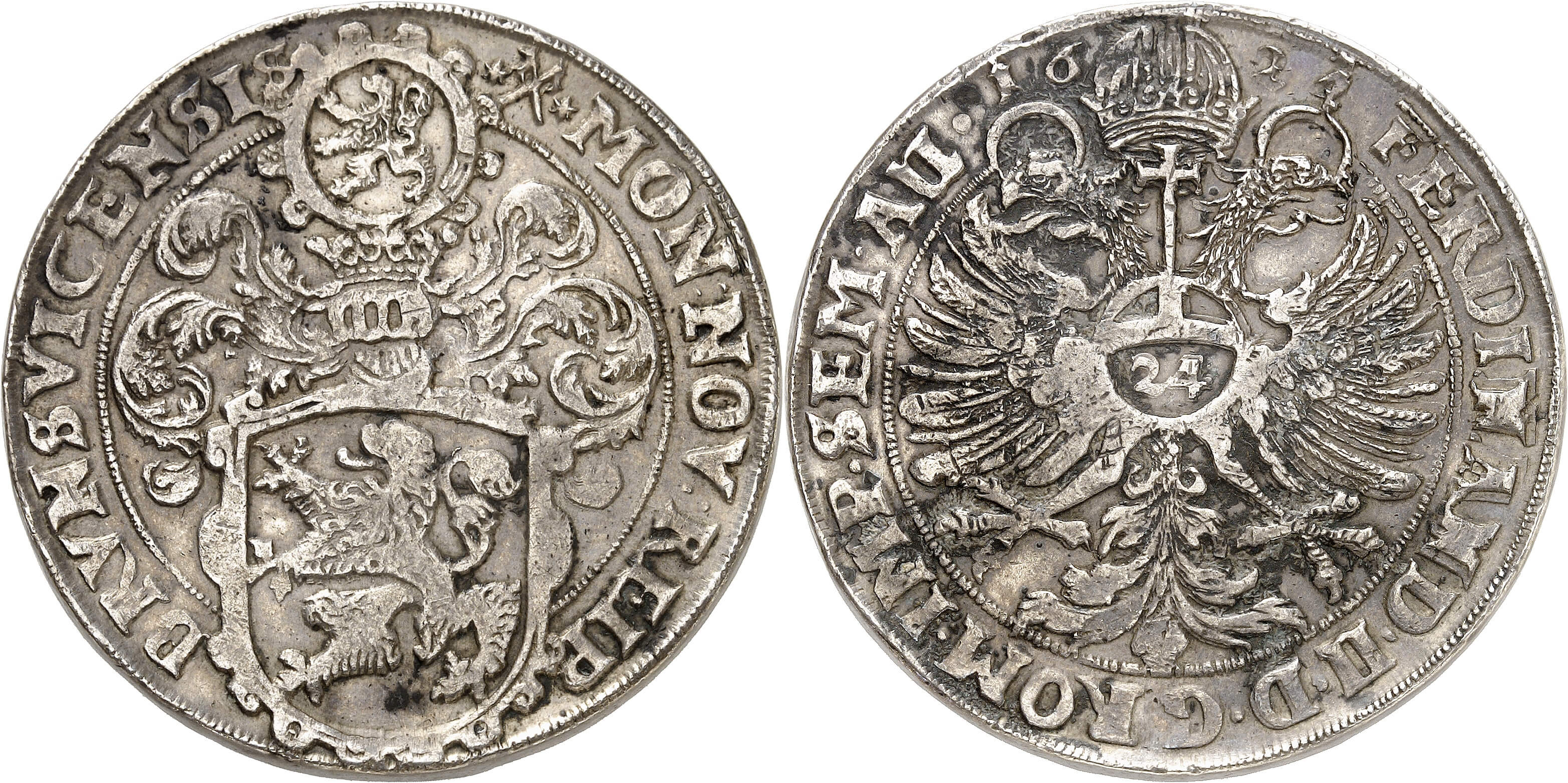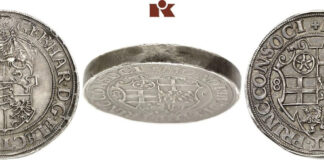A Wealth of Special Collections
From 22 to 26 June 2020, Künker’s two Summer Auction Sales take place. From Monday to Friday, more than 3,600 lots with a total estimate of 5.2 million euros will be offered. The Summer Auction Sales will be held as in-room auction, and obviously all hygiene requirements of the authorities will be met. For those who cannot or do not wish to be there in person, live bidding is possible at Auex without additional fees. And, of course, there are the usual options of bidding via e-mail or phone.
Viewing takes place in the premises of Künker by prior appointment only – also during the auction. For all those who can’t attend the viewing, Kuenker has developed a completely new feature: selected lots can be examined in detail in a video. You will see the lots just like you were taking a look at them while viewing. All videos are available at the Künker website.
Several special collections will be auctioned off in the Summer Auction Sales, namely the Dr. Hergen Boyksen Collection with coins and medals from Schleswig-Holstein, a comprehensive collection with the coins and medals of the counts and princes of the House of Lippe, the Dr. Werner Oschmann Collection of mining and yield coins, a special collection Bavaria and the collection of Russian coins and medals of a “lawyer from the North”.
Moreover, there are many different series and individual pieces of coins from Germany and world coins. Thus, there’s something for everyone.
Coins and Medals from Schleswig-Holstein: The Boyksen Collection
Auction 337 begins with the 303 lots of the Boyksen Collection. From medieval pfennigs of the Viking Age settlement of Haithabu to double Friedrichs d’or minted in Altona for the Danish king Frederick VII: notary Dr. Hergen Boyksen collected coins and medals related to Schleswig-Holstein. He paid attention to outstanding quality and rarity, which means that his collection contains both many spectacular rarities as well as pieces affordable to normal collectors. The estimates range from 25 euros to 150.000 euros.
Lovers of medieval coinage will find half bracteates from Haithabu, denarii of the Danish kings, bracteates of the Counts of Schauenburg as well as wittes of the “Wendischer Münzverein”. Next are issues of the Danish kings as Dukes of Schleswig-Holstein, including a first highlight: the Husum taler of 1522. The piece estimated at 50,000 euros is one of the earliest talers of northern Europe.
Even rarer is the group at the beginning of the chapter on coins of the duchies of Schleswig-Holstein: a portugaleser issued in Eutin by Johann Adolf von Holstein-Gottorp (estimate: 150,000 euros) is on sale as well as two half portugalesers of the same prince (estimate: 50,000 euros each).
Extensive series of coins and medals from the Dioceses of Lübeck and Ratzeburg, of the collateral lines of the House of Holstein and the County of Rantzau round off the offer.
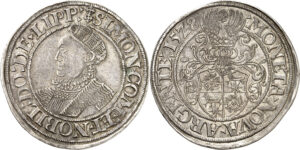
Coins and Medals of the Counts and Princes of the House of Lippe
The special collection “Lippe” comprises 86 lots with coins and medals from medieval times to the German Empire. The rarest piece of the auction is the so-called “Köterberg taler” struck in 1528. There exist only four specimens of this rarity. This piece comes from the Köhlmoos Collection, and is the only one available on the market.
Other rarities are a pattern for a taler of Simon Henry, minted in 1672 in Detmold (estimate: 30,000 euros) and a broad 5-ducat off-strike from the dies of the ducat of 1673 (estimate: 40,000 euros).
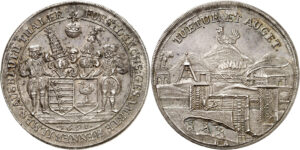
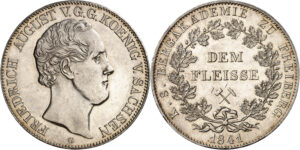
Mining and Yield Issues from the Dr. Werner Oschmann Collection
Attentive readers will spot pieces from the Dr. Werner Oschmann Collection of mining and yield coins and medals in different parts of auction 337. Those interested in the history of technology will find exciting pieces: Many die engravers crafted wonderful depictions of the various production steps of silver ore mining and the necessary technical equipment. The collection obviously focuses on the most important mining districts of the German States as Brunswick, Henneberg, Hesse, Hohnstein, Saxony and Stolberg.
Additionally, Dr. Werner Oschmann also collected yield coins; his collection of river gold ducats can be found in catalogue 338.
Coins and Medals from the German States
From Tuesday morning to Wednesday afternoon, issues of the German States will be on sale. From A as in Altenburg to W for Würzburg, the numismatic journey contains numerous highlights. For example a double reichstaler of the city of Brunswick made in 1624, probably the second known specimen (estimate: 30,000 euros), a Lübeck reichstaler of 32 schillings made in 1712 (estimate: 35,000 euros) and a reichstaler of the Paderborn bishop Franz Arnold von Wolff-Metternich zur Gracht, minted in 1716 in Neuhaus (estimate: 30,000 euros).
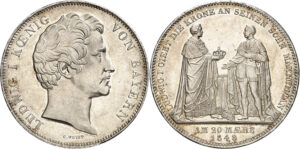
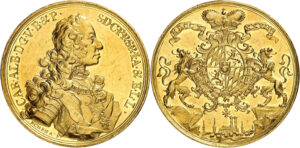
Special Collection Bavaria
On Tuesday, another special collection will be on offer. 255 lots with coins and medals from Bavaria are waiting for new owners. The time frame ranges from the issues of the duchy under Albert V (1550-1579) to the legendary Prince Regent Luitpold (1886-1912).
Many collectors will be pleased that, for once, high-priced rarities are not at the centre of attention but a wealth of interesting pieces in the mid-price segment. However, especially regarding rare issues of extraordinarily well quality the estimated price might well be surpassed in the auction. Let’s take the example of an extremely rare half reichstaler from 1694, minted in Munich, featuring the detailed image of the Patrona Bavariae on the reverse – without the usual adjustment marks. It’s estimated at 2,500 euros. We’ll see what the result will be.
There are also historically interesting medals on offer, for example a medal of elector Charles Theodore, who was quite unpopular in Bavaria, commemorating his deceased predecessor Maximilian III Joseph, who had died on 30 December 1777.
Lovers of the commemorative coins of Louis I (“geschichtstaler”) will find a rich selection of different types of great quality in auction 337.
For Bavarian gold coins, you have to open catalogue 338. 42 lots from Louis the Bavarian to Ludwig II, from 250 euros up to 60,000 euros can be spotted here. The highlight is a 10 ducats piece from 1739 featuring the skyline of Munich on the reverse (estimate: 60,000 euros).
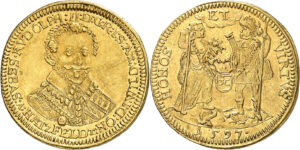
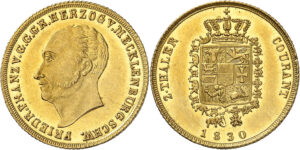
Gold Coins and Medals from the German States
And now we arrived at auction catalogue 338 containing exactly 250 lots with gold issues from the German States. In addition to the already mentioned yield coins, the small series of 20 rare gold coins from Mecklenburg is definitely a highlight. It includes a gem, a double taler in gold minted in 1830 in Schwerin with an estimate of 25,000 euros.
German Coins After 1871
Of course, also this auction offers a comprehensive series of German coins minted after 1871. After all, that’s one of Künker’s specialties.
World Issues
Even though the focus of the 2020 Summer Auction Sales is rather on German issues, a close look is also worthwhile for collectors of world coins. Coins and medals of the Habsburg hereditary lands, for example, are represented with numerous exciting pieces. Connoisseurs will spot a comprehensive series of talers and several rare gold issues, including a quadruple ducat featuring the portrait of Emperor Joseph II, minted in 1786 in Vienna (estimate: 40,000 euros).
Catalogue 338 is a must-see for everyone interested in French gold coins. From the rare gold coins of Philip the Fair to an eightfold Louis d’or of Louis XIII (estimate: 100,000 euros) and to many other gold coins of the Bourbons of magnificent quality: experts will find a wealth of great rarities of French coinage.
At this point we would like to mention a series of motif patterns issued in 1848. One encounters the tin version of these pieces rather often, and occasionally even the copper version – however, the silver series is very rare. A collector was lucky enough to find 26 specimens, which will be auctioned off individually in auction 337.
Of course, there are also numerous rarities to be found in other fields. For example a Triple Unite from 1642, minted for the English king Charles I in 1642 in Oxford (estimate: 50,000 euros).
Russian Coins and Medals: The Collection of a “Lawyer from the North”
On Friday afternoon, the auction ends with Russian coins and medals, mainly from the collection of a lawyer from the North. 988 lots are on offer and, thanks to the low estimates, they will certainly find a new home. There are numerous issues with a starting price in the lower three-digit range, even though there are obviously numerous pieces in the five-digit range as well. Among them are a rouble of tsar Elizabeth from 1757, whose die was made by Swiss medallist J. Dassier (estimate: 25,000 euros), an extremely fine gold medal of tsar Paul I weighing 10 ducats featuring a cross on the reverse (estimate: 50,000 euros), a family rouble (estimate: 30,000 euros) and a platinum rouble of 1859 (estimate: 20,000 euros).
The catalogues can be ordered at Künker, Nobbenburger Straße 4a, 49076 Osnabrück; phone: +49 541 / 96202 0; fax: +49 541 / 96202 22; or via e-mail. You can access the auction catalogues online. If you want to use live bidding, please remember to register for this service in good time.
Künker will inform about any changes, e.g. of the schedule or the location of the auction, in the Künker newsletter or at the Künker website.




